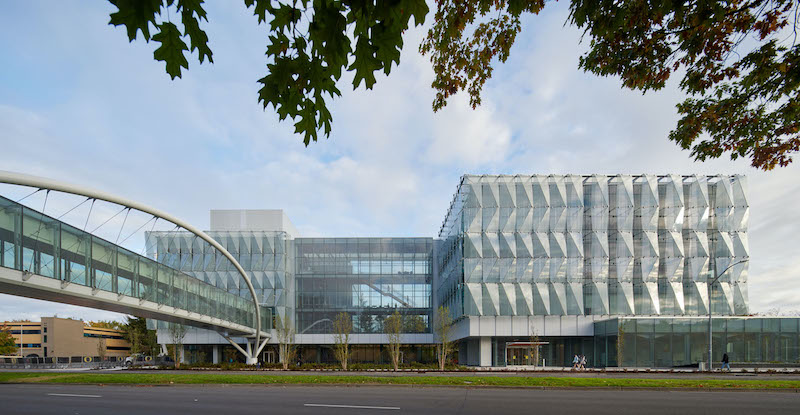Earlier this month, the University of Oregon in Eugene opened the Phil and Penny Knight Campus for Accelerating Scientific Impact. The 160,000-sf complex, which consists of two facing L-shaped towers, supports a mission to shorten the timeline between discovery, development, and deployment by bringing together engineering, applied science, business innovations, and culture. Its environment priorities revolve around wellness, human performance, and community. (The Campus’s tagline is “Science Advancing Society.“)
Phil Knight, co-founder and chairman emeritus of Nike, donated $500 million for this project. “Phil was most interested in the mission” of acceleration, Todd Schliemann, FAIA, Design Partner at Ennead Architects, tells BD+C. The Campus’s current focus is bioengineering, and OU partners with Oregon State University to offer a PhD program in that discipline.
Ennead Architects was this project’s design architect, Portland, Ore.-based Bora Architecture & Interiors was its AOR and designed some of the interiors, and Hoffman Construction built the campus.
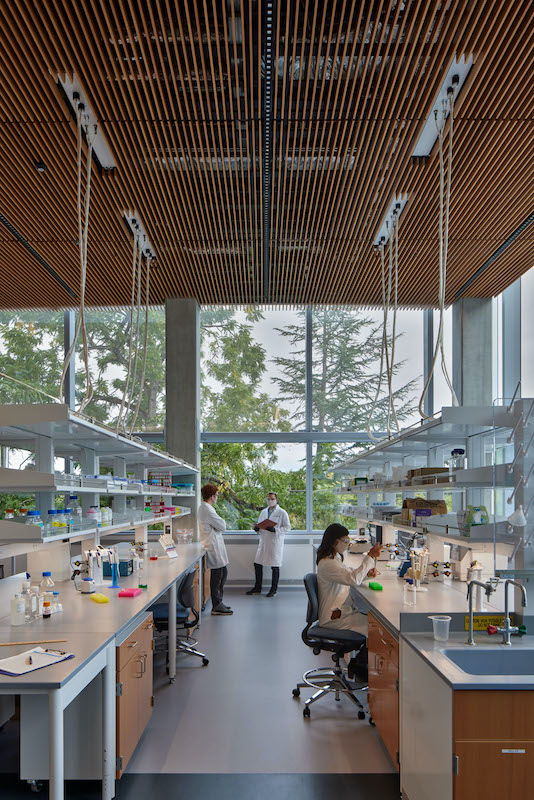
Lab space (above) and work space (below) intersect in the campus's buildings. Mass timber was applied throughout the Campus, including the labs' ceiling.
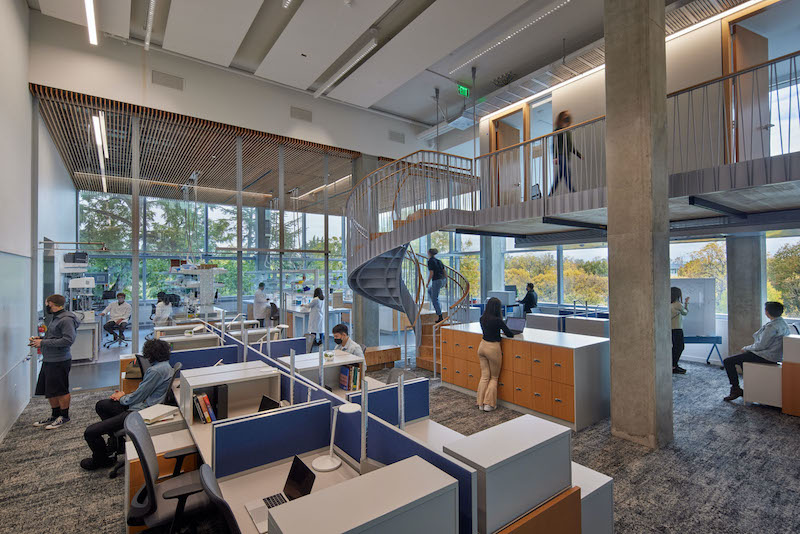
Built on land where a Domino’s Pizza, a mini-mall and parking lot once stood, the Knight Campus is situated between the University of Oregon’s main campus and parkland straddling the Willamette River. A 190-ft-long, 48-ft-wide enclosed bridge, stretching 35 ft above street traffic, connects Knight Campus to Oregon’s existing campus.
Schliemann says the university is positioning the Knight Campus—which he calls a “humanistic research machine”— as a “gateway building” to a possible future research complex.
During the design process, the university hadn’t decided what disciplines these towers would house. So before designing the Knight Campus, representatives from the design team visited several other universities, including MIT’s Media Lab, Harvard, Stanford, and University of California at San Francisco. What they all have in common, says Schliemann, are collaborative spaces where knowledge can be shared. Stanford’s engineering complex, he adds, is noteworthy for how much natural light it lets inside.
‘NEIGHBORHOODS’ BRING RESEARCHERS TOGETHER
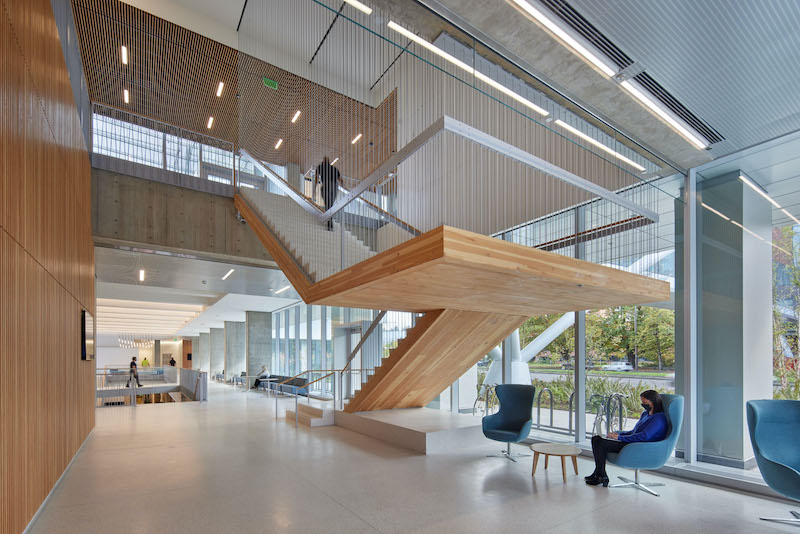
Staircases made from cross-laminated timber connect the floors.
The Knight Campus has several distinguishing characteristics:
•Its two upper floors include four research “neighborhoods” that each has a wet bench area, computational space, and offices where Principal Investigators work. Schliemann contends that this is one of the first lab buildings in the U.S. where PIs are this visible to other research teammates.
•The Campus’s double-skinned façade showcases an outer wall consisting of 650 glass panels and designed to resemble water flowing over rocks. This cascading wall is stabilized by an inner curtainwall made up of 900 glass panels. Schliemann says that this design and materials were chosen to let more natural light and panoramic exterior views into the building (which, he contends, improves working conditions), and for passive energy performance (the inner wall of the façade never gets exceedingly warm).
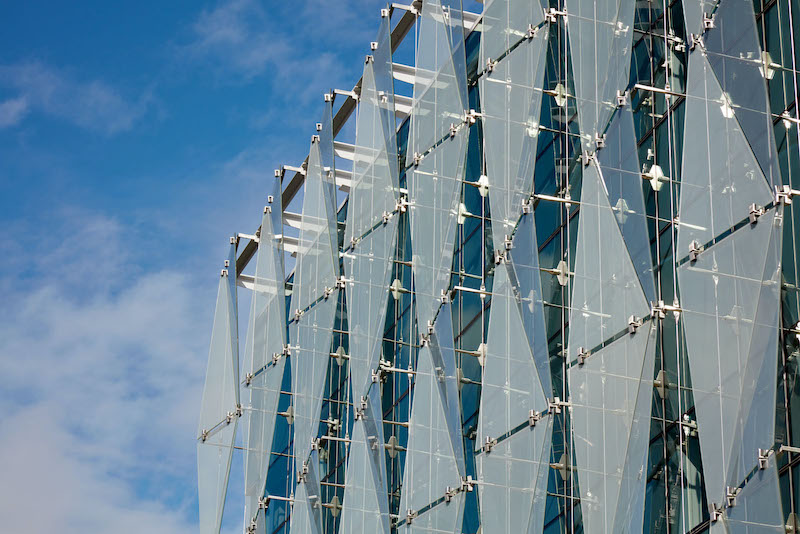
The Campus's double-skinned facade lets more natural light into the buildings and keeps heat from penetrating the inner curtainwall.
The wall structure was light enough to be hung from the roof component.
•Mass timber is prevalent throughout the Knight Campus, whose construction used 20,500 sf of cross-laminated timber that includes 180 CLT panels and 4,000 lbs of wood for each of the building’s staircases. The 21-foot floor-to-floor height allows for suspended mezzanine structures of mass timber containing offices for faculty, creating a new level of connectivity to their labs and graduate students.
Mass timber “is one of the most sustainable ways to construct a building” says Schliemann. (The Knight Campus is targeting LEED Gold certification.) Using mass timber also supports Oregon’s local economy. While vibration prevents a lab space from being made entirely with mass timber, “we could use it for offices, stairs, ceilings and bridges. Plus, we didn’t have to sheetrock the ceilings, as fire codes have finally caught up with mass timber” as a fireproofing agent.
Also see: Researchers use U. of Arkansas buildings as testbed for CLT panels.
SPACES FOR FORMAL OR RELAXED INNOVATION AND INTERACTION
Among the Knight Campus’s amenities are a 6,000-sf Innovation Center and 1,000-sf Wellness Center. While the Innovation Center might seem small when compared to other university research facilities, Schliemann counters that its scale is deceptive. “It gets innovators out into the real world.” He adds that all Knight Campus labs are leasable and tenant-adaptable.
The Wellness Center started out as a locker room with showers. Then spaces for yoga and other exercise regimens were included. Schliemann says the campus has a program where students can take bike rides with researchers.
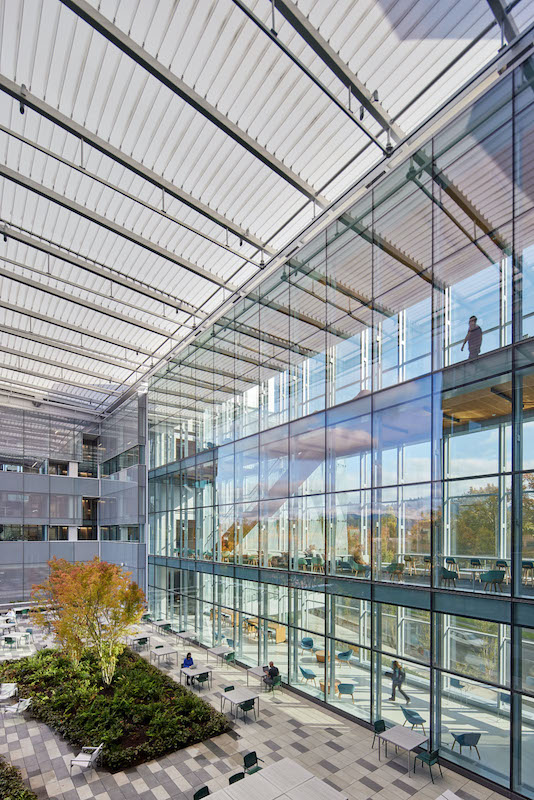
An elevated terrace and courtyard between the Campus's two buildings is covered with a canopy made from ETFE.
Between the Campus’s two buildings is an elevated terrace and courtyard, protected by a transparent plastic canopy, where students and faculty can relax, socialize, and connect with nature, as the terrace overlooks landscaping and the tree-covered Coburg Hills.
Related Stories
| Aug 11, 2010
Burt Hill, HOK top BD+C's ranking of the nation's 100 largest university design firms
A ranking of the Top 100 University Design Firms based on Building Design+Construction's 2009 Giants 300 survey. For more Giants 300 rankings, visit http://www.BDCnetwork.com/Giants
| Aug 11, 2010
PCL Construction, HITT Contracting among nation's largest commercial building contractors, according to BD+C's Giants 300 report
A ranking of the Top 50 Commercial Contractors based on Building Design+Construction's 2009 Giants 300 survey. For more Giants 300 rankings, visit http://www.BDCnetwork.com/Giants
| Aug 11, 2010
Webcor, Hunt Construction lead the way in mixed-use construction, according to BD+C's Giants 300 report
A ranking of the Top 30 Mixed-Use Contractors based on Building Design+Construction's 2009 Giants 300 survey. For more Giants 300 rankings, visit http://www.BDCnetwork.com/Giants
| Aug 11, 2010
Jacobs, HDR top BD+C's ranking of the nation's 100 largest institutional building design firms
A ranking of the Top 100 Institutional Design Firms based on Building Design+Construction's 2009 Giants 300 survey. For more Giants 300 rankings, visit http://www.BDCnetwork.com/Giants
| Aug 11, 2010
Polshek Partnership unveils design for University of North Texas business building
New York-based architect Polshek Partnership today unveiled its design scheme for the $70 million Business Leadership Building at the University of North Texas in Denton. Designed to provide UNT’s 5,400-plus business majors the highest level of academic instruction and professional training, the 180,000-sf facility will include an open atrium, an internet café, and numerous study and tutoring rooms—all designed to help develop a spirit of collaboration and team-oriented focus.
| Aug 11, 2010
UCLA to get more graduate housing
The University of California, Los Angeles, has begun a new graduate housing project that will occupy 275,000 sf of the campus. The Wayburn Terrace Graduate Housing Project, led by California-based construction management and consulting firm Gafcon, includes a residential building comprising 500 studio apartments, a commons building, and administrative offices.
| Aug 11, 2010
Fashion school gives old building a make over
A new art facility for LIM, the College for the Business of Fashion, in midtown Manhattan is the result of a gut renovation of a six-story townhouse-school built in 1880. The new facility will continue LIM's mission of educating undergraduates on the business side of fashion. Architecture firm Butler Rogers Baskett transformed the old building's claustrophobic layout into a modern, multifunctio...
| Aug 11, 2010
Biomedical center to join London's research scene
The UK Centre for Medical Research and Innovation, a partnership of scientific organizations researching new treatments for illnesses such as cancer and heart disease, hopes to attract leading medical scientists to its planned research center. Designed by HOK London, the building will be located on 3.
| Aug 11, 2010
San Diego Mesa College enhances math and science facilities
A $92 million, 180,000-sf instructional center soon will rise at the heart of San Diego Mesa College in California. Slated to open in November 2012, the Math and Science Building will be funded by Propositions S and N construction bond program. The blueprint calls for four floors of classrooms, laboratory space, and offices for several science departments.
| Aug 11, 2010
Tufts University puts bite into new dental school addition
The recently dedicated Tufts University School of Dental Medicine, in Boston, represents the culmination of a 22-month vertical expansion of the school's original 1972 building. The $68 million project involved constructing five new stories totaling 95,000 sf atop the building's existing 10 stories, which were also remodeled.


